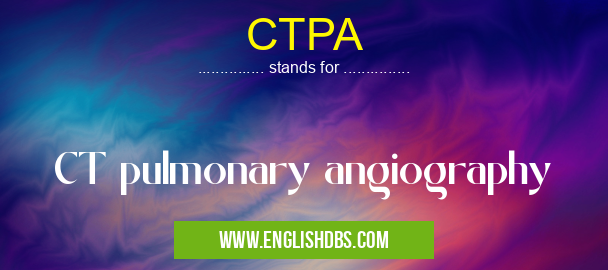What does CTPA mean in BRITISH MEDICINE
CTPA, or CT pulmonary angiography, is a diagnostic imaging technique used to diagnose and evaluate blood circulation in the pulmonary arteries. This procedure involves using an intravenous contrast dye for X-ray imaging of the lungs, as well as other associated structures. By producing detailed computerized images of the lungs and their surrounding areas, this procedure can detect any blockages, clots, masses or other abnormalities that may be present.

CTPA meaning in British Medicine in Medical
CTPA mostly used in an acronym British Medicine in Category Medical that means CT pulmonary angiography
Shorthand: CTPA,
Full Form: CT pulmonary angiography
For more information of "CT pulmonary angiography", see the section below.
Benefits
The main benefit of CTPA is that it provides extremely accurate and detailed images of the lungs and their surrounding structures. These images are able to provide information about any potential blockages or abnormalities that may be present in the pulmonary arteries, allowing medical professionals to identify any potential problems quickly and accurately. Additionally, CTPA is non-invasive, meaning it does not require any invasive surgery or procedures such as bronchoscopies, making it a safer alternative to these types of tests.
Procedure
The procedure for a CTPA scan typically begins with the patient receiving an intravenous injection of a radiocontrast agent. Once this has been administered, the patient will be asked to lie on a table while a special type of X-ray machine rotates around them creating multiple cross-sectional images of the chest cavity area. From these images, medical professionals are able to diagnose any potential issues with blood flow within the pulmonary arteries.
Essential Questions and Answers on CT pulmonary angiography in "MEDICAL»BRITMEDICAL"
What is CT pulmonary angiography?
CT pulmonary angiography (CTPA) is a medical diagnostic procedure used to examine the lungs, pulmonary arteries, and surrounding structures. It is a type of computed tomography (CT) scan which specifically looks at the blood vessels in the lungs.
When is CTPA usually recommended?
CTPA may be recommended if a patient has signs or symptoms of a pulmonary embolism or other lung diseases such as cancer, infection, or inflammation. It can also be used to diagnose other conditions affecting the heart and blood vessels in the chest.
How long does it take for CTPA to be completed?
The entire procedure typically takes about 30 minutes. However, this may vary depending on the specific procedure being performed and individual factors such as body size and how much contrast agent needs to be injected.
Is CTPA painful?
Typically no, but you may experience some brief discomfort when IV contrast material is injected for the exam. Most patients describe this as a slight burning sensation that lasts for just a few seconds.
What are some potential risks associated with a CTPA procedure?
Possible risks include an adverse reaction to contrast material, allergic reaction and rarely radiation exposure from repeated imaging procedures over time. Your doctor will discuss any risks with you prior to your appointment so that you can make an informed decision about whether it's right for you or not.
Do I need a referral from my doctor before getting a CTPA?
Yes, most medical insurance companies require that you get referred by your physician before undergoing the procedure so it's best to check with your provider ahead of time to make sure all necessary documentation has been taken care of prior to your appointment.
How should I prepare for my CTPA appointment?
You may need to fast prior to the exam so make sure you consult your doctor or technician beforehand regarding any dietary restrictions they recommend on the day of your scan. Depending on which parts of your body are being examined during the procedure you may also need to remove any jewelry, watches or other metal objects on or near those areas since they could interfere with imaging quality.
Can I eat after having a CTPA scan?
Generally yes, once the exam is complete you can eat normally again unless otherwise instructed by your physician or technician due to individual circumstances surrounding your particular case.
Who interprets my results from a CTPA scan?
Results from examinations performed utilizing advanced technological equipment such as computed tomography scans are typically interpreted by radiologists who specialize in interpreting images produced by such scans and more generally issues concerning radiology and oncology imaging techniques in general.
Final Words:
In conclusion, CT pulmonary angiography (CTPA) is an important diagnostic tool utilized by medical professionals for diagnosing blood circulation issues in the pulmonary arteries. The procedure involves injecting a radiocontrast agent intravenously before taking several cross-sectional X-ray images which can help detect any blockages or abnormalities that may be present in these vessels. CTPA is also non-invasive so it carries minimal risk compared to more traditional testing methods.
